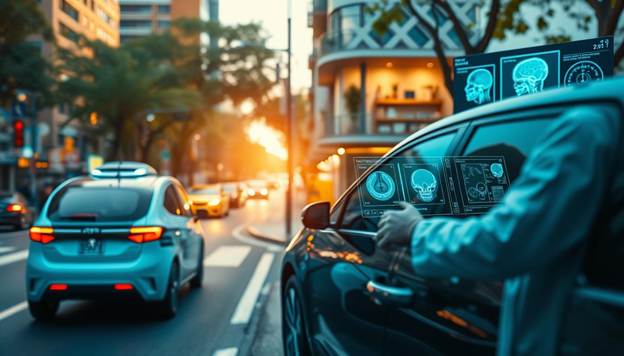What is machine learning? A beginner-friendly guide |InfoCrazee|
Imagine being able to teach a computer to recognize objects, make predictions, or decisions, just like you would teach a child. This is the essence of Machine Learning, a subset of artificial intelligence that involves training algorithms to learn from data. By showing a computer examples, it can improve its performance on a task over time, much like a child learns from experience.

Machine Learning is revolutionizing the world by enabling computers to make decisions and predictions based on data. This beginner-friendly guide will introduce you to the basics of Machine Learning and its significance in today’s world.
Key of learning
- Machine Learning is a subset of artificial intelligence.
- It involves training algorithms to learn from data.
- Computers can improve their performance on a task over time.
- Machine Learning has numerous applications in today’s world.
- It’s used in various industries, including data science.
Understanding Machine Learning
The idea of machine learning is to enable machines to make predictions or decisions based on data. This concept has revolutionized the way we approach complex problems, making it possible to analyze vast amounts of data quickly and accurately. Machine learning is a subset of artificial intelligence that involves training algorithms on data, which enables them to learn and improve over time.

The Basics of Machine Learning
Machine learning is based on the idea that machines can learn from data without being explicitly programmed. The basics involve training algorithms on data, which enables them to make predictions or decisions. There are different types of machine learning, including supervised and unsupervised learning. Supervised learning involves training a model on labeled data, whereas unsupervised learning involves training on unlabeled data.
How Machines Learn from Data
Machines learn from data by identifying patterns and relationships. This process involves using algorithms to analyze the data, which enables the machine to make predictions or decisions. For instance, in unsupervised learning, machines can discover hidden patterns in data, while in deep learning, complex neural networks are used to analyze data. The insights gained from this process can be used to improve decision-making and prediction accuracy.
Some key aspects of machine learning include:
- Training algorithms on data
- Making predictions or decisions based on data
- Improving model accuracy over time
- Using deep learning and neural networks for complex data analysis
Types of Machine Learning You Should Know
Machine learning encompasses a range of approaches, including supervised, unsupervised, and deep learning. These categories are not mutually exclusive, and they often overlap or are used in conjunction with one another to achieve specific goals.
Supervised Learning: Learning with Guidance
Supervised learning involves training a model on labeled data, where the correct output is already known. This type of learning is akin to a student learning from a teacher who provides the correct answers. The model learns to map inputs to outputs based on the labeled data, enabling it to make predictions on new, unseen data. Supervised learning is widely used in applications such as image classification, speech recognition, and predictive analytics. For instance, in image classification, a model is trained on a dataset of images labeled as “cats” or “dogs,” allowing it to learn and predict the classification of new images.

Unsupervised Learning: Finding Hidden Patterns
Unsupervised learning involves training a model on unlabeled data, and the model identifies patterns and relationships on its own. This type of learning is useful for discovering hidden structures in data, such as clustering similar data points or dimensionality reduction. Unsupervised learning is particularly valuable when the data’s underlying structure is not well understood. For example, clustering customers based on their buying behavior can help businesses identify new market segments.
Deep Learning and Neural Networks
Deep learning is a subset of machine learning that involves the use of neural networks to analyze complex data. Neural networks are modeled after the human brain and consist of layers of interconnected nodes or “neurons.” These networks are capable of learning and improving their performance over time, especially when dealing with large amounts of data. Deep learning has achieved state-of-the-art results in various applications, including computer vision, natural language processing, and speech recognition. For instance, deep learning models can be used to diagnose medical images, translate languages, and generate text or speech.
“The development of deep learning has revolutionized the field of machine learning, enabling machines to perform tasks that were previously considered the exclusive domain of humans.”
Machine Learning in Everyday Life
Machine learning is increasingly becoming a part of our daily lives, transforming the way we interact with technology. It is being integrated into various applications and services that we use daily, often without us even realizing it.

Popular Applications You Already Use
Many popular applications rely on machine learning to function effectively. For instance, virtual assistants like Siri and Alexa use natural language processing, a subset of machine learning, to understand and respond to voice commands. Similarly, streaming services like Netflix and Spotify employ machine learning algorithms to provide personalized recommendations based on users’ past preferences and behaviors.
Image recognition, another significant application of machine learning, is used in various fields, including security systems and social media platforms, to identify and tag individuals in images.
Getting Started with Machine Learning
To get started with machine learning, one can explore online resources and courses that teach the fundamentals of predictive models and the importance of training data. Working on projects that involve training models on data can provide hands-on experience. With the increasing availability of data and computational resources, machine learning is becoming more accessible to individuals and organizations.
By understanding the basics of machine learning and its applications, individuals can better appreciate the technology that surrounds them and potentially leverage it for their own purposes or projects.
Conclusion
Machine Learning is revolutionizing the world by enabling machines to learn from data and improve their performance over time. As discussed, Machine Learning encompasses various types, including supervised, unsupervised, and deep learning, each with its unique applications and benefits. From enhancing customer experiences to improving healthcare outcomes, the impact of Machine Learning is vast and diverse. As data science continues to evolve, it’s essential to stay informed about the possibilities and applications of Machine Learning. With its increasing accessibility, Machine Learning is poised to have a significant impact on various aspects of our lives, making it an exciting and rapidly advancing field.
FAQ
What is the difference between supervised and unsupervised learning in machine learning?
Supervised learning involves training a model on labeled data, where the correct output is already known, whereas unsupervised learning involves training on unlabeled data, and the model identifies patterns and relationships on its own.
What is deep learning, and how does it relate to machine learning?
Deep learning is a subset of machine learning that involves the use of neural networks to analyze complex data. Neural networks are modeled after the human brain and consist of layers of interconnected nodes or “neurons” that are capable of learning and improving their performance over time.
How do machines learn from data in machine learning?
Machines learn from data by identifying patterns and relationships, which are then used to make predictions or decisions. This is achieved through training algorithms on data, which enables them to improve their performance on a task over time.
What are some common applications of machine learning in everyday life?
Machine learning has numerous practical applications, including image recognition, natural language processing, and recommender systems. Many popular applications, such as virtual assistants like Siri, Google Assistant, and personalized product recommendations on Amazon, rely on machine learning.
How can I get started with machine learning, and what are the prerequisites?
To get started with machine learning, one can explore online resources, take courses on platforms like Coursera, edX, or Udemy, and work on projects that involve training models on data. A basic understanding of programming concepts, data structures, and statistics is helpful, as well as familiarity with popular machine learning libraries like TensorFlow or PyTorch.
What is the role of training data in machine learning, and how does it impact the performance of a model?
Training data plays a crucial role in machine learning, as it is used to train algorithms and enable them to make predictions or decisions. The quality and quantity of training data can significantly impact the performance of a model, with high-quality data leading to better performance and more accurate predictions.





